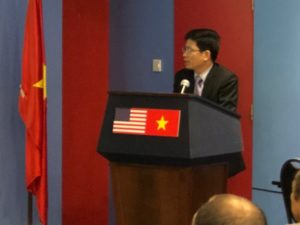Thursday, March 8
Katie Mansouri, Wade Meteer, & Jonathan Schneider – Presiding Fellows
Our day was packed with activities. Our group started at the United States Embassy in Hanoi, Vietnam. While at the Embassy, we heard from various experts from the Agriculture sector. Deputy Chief of Mission for the US Embassy in Vietnam, Caryn McClelland, spoke about her role in advancing American and Vietnamese relations and helping both countries prosper. DCM McClelland explained US relations with Vietnam have improved and are stronger than ever. President Trump’s visit to the country within his first year in office and the first US air craft carrier (since the Vietnam War) landing in Da Nang, Vietnam, the day before we arrived, support her statement.

Deputy Chief of Mission for the US Embassy in Vietnam, Caryn McClelland, addresses the IALP Class of 2018 on current relations between the United States and Vietnam.
Following McClelland’s presentation, Tran Van Cong, AGROTRADE Department Deputy Director, Vietnam Ministry of Agriculture and Rural Development, provided specifics on Vietnam’s key agriculture exports: coffee, fisheries, timber, timber products, cashew nuts, fruits, vegetables, rice, pepper, and rubber. Cong’s presentation was complimented by the next speaker, Benjamin Petlock, Agricultural Attaché for the US Embassy. Petlock provided an overview of Vietnam’s culture, political system, and agriculture sector. It was interesting to learn Vietnam is now the number one importer of US cotton.

Tran Van Cong, AGROTRADE Department Deputy Director, Vietnam Ministry of Agriculture and Rural Development, presents information to the Class of 2018 on Vietnam ag production and initiatives.
Dr. Conrad Estrada, APHIS Area Director, has been charged with opening the new office in Vietnam. Dr. Estrada provided an overview of APHIS’ crucial role within the region to ensure trade negotiations include the technical requirements for agriculture products are included. His presentation made clear that APHIS’ role is crucial to solve problems and make safe trade happen.
Chien Tran, Agricultural Consulting Company (AGS) closed our session at the US Embassy. Tran highlighted Vietnam’s growing need for corn and soybeans for animal feed. In 2017, Vietnam imported 1.7 million tons of soybeans and 5 million tons of soybean meal, these numbers have doubled since 2012. Vietnam’s need for animal feed is projected to continue growing.
After our visit at the US Embassy, the group ate a traditional Vietname meal and then headed to CP Viet Nam: chicken slaughter house and meat processing plant. The group was amazed to learn the breast meat is used to make sausages because dark meat is preferred in country. The day closed with a dinner with the I-Lead (Iowa) Leadership Class 8 and the Water Puppet Show.

The IALP Class of 2018 during their visit at the CP Viet Nam chicken processing plant.

